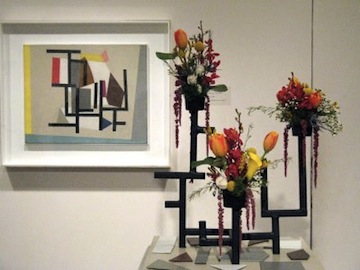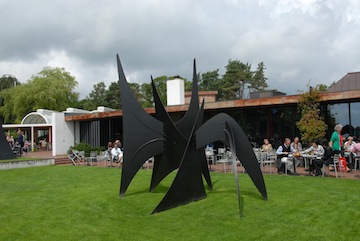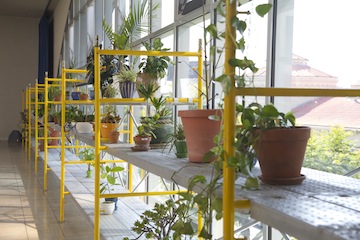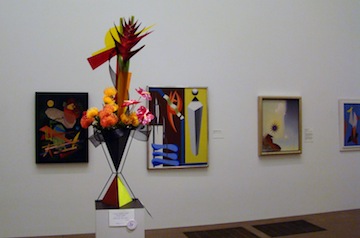
Floral design by the Hopkinton Garden Club, Flora in Winter, Worcester Art Museum, 2009. Image via the museum website. Interpretation of “Untitled” by Ilya Bolotowsky.
As a visitor walking around an art venue, it’s refreshing and pleasing to stumble across green spaces. Open-air and enclosed courtyards featuring lush vegetation and bubbling fountains, outdoor terraces and cafés, rooftop and sculpture gardens – these snapshots of nature have become de rigueur inclusions in the physical layout of museums and galleries. But how are these spaces used? What are new and creative ways in which museum staff are utilizing these natural areas for events, participatory programs, and exhibitions? Can we foresee the direction of their evolution? To try and answer some of these questions, I have asked Nina Simon, author of The Participatory Museum (2010) and founder of design consultancy Museum 2.0, for an insider’s take on enhancing the visitor experience in these spaces.
Meg Floryan: Art museums are often seen as cold, white-walled institutions with strictly defined areas and rules of behavior. Are you seeing these attitudes and approaches relaxing? That is, do you see it as advantageous for museum layouts to become more or less compartmentalized?
Nina Simon: I definitely see it as advantageous to design museums for diverse use — but I don’t see that being different now than it was ten or twenty years ago. The best museums have always provided people with a range of settings, flooring, and stimulus. For hundreds of years, for example, German art museums have interspersed galleries with window nooks where people could sit and rest their eyes between viewing artworks. The need for a multifaceted experience is nothing new.
MF: What are some of your personal favorite programs or exhibitions that have been staged in museum green spaces? What are your least favorite?
NS: One of my favorite museums in the world is the Louisiana Museum of Modern Art, north of Copenhagen. The museum is an incredible retreat, a fluid indoor-outdoor experience that takes you through winding galleries and rolling hills with incredible views across the sea to Sweden. There’s even a secret garden with installation works carved into the woods — a wonderland for a few intrepid visitors willing to open a nondescript side door. Yes, the Louisiana has great art, but more than that, it’s an inspiring, relaxing experience due to its natural setting and the integration of green spaces into the whole art experience.

Alexander Calder, “Stender Ribs,” 1963. Louisiana Museum of Modern Art, Denmark. Image via Flickr. Photo by FaceMePLS.
Another wonderful place is the outdoor sculpture garden at the Walker Art Center in Minneapolis. In this case, the outdoors is somewhat discontinuous from the inside. While the museum is beautiful, the sculpture garden is a true community commons — used by any and everyone enjoying the city outdoors. It’s free. It’s open. It’s easy to get to. And the hedging and separation of the installations visually allow you to spend time with the sculptures without being distracted by a jumble of other works.

Claes Oldenburg and Coosje van Bruggen, “Spoonbridge and Cherry,” 1985-88. Walker Art Museum, Minneapolis. Image via Flickr. Photo by meetminneapolis.
I don’t have a “least favorite” green space experience. I do think it’s a mistake when a museum has a beautiful green space and doesn’t choose to activate it — even lightly — with content. Too often we segment spaces into content or non-content. Bathrooms, parking lots, courtyards, rooftops, can all be big parts of visitors’ experiences and are often content-free. If a family is picnicking on your lawn, why not give them some art to enjoy as part of that experience?
MF: How do you see the use of such spaces changing as our design and curatorial perspectives evolve?
NS: I do see some museums moving toward a much more integrated approach toward the whole space, the whole experience. One of my favorite trends is the “leaking” of art elements into atypical parts of the museum. For example, at the Hammer Museum in Los Angeles, the Machine Project has been staging art encounters in closets under the stairs and in other interstitial places.

Machine Project, Plant Vacation, August 2010. Hammer Museum, Los Angeles. Image via Flickr. Photo by the Machine Project.
This isn’t just about curatorial and design perspectives; it’s also about the business of crafting a holistic “guest experience.” For example, over the last several years, many museums have brought food service back under their domain (after years of subcontracting) and have added menu items inspired by artworks to keep the art context constant.
MF: I’ve noticed in my own career of museum-visiting that guests tend to be more relaxed and open to interaction in green spaces such as garden courtyards or outdoor cafés. You’ve recently hosted a book discussion on your site regarding Ray Oldenburg’s The Great Good Place and the concept of so-called “third places.” Do you see natural spaces in art centers as potentially adequate third places?
NS: Sort of. Certainly cafes and courtyards are fabulous places for people to relax and chat during a visit—I suspect most visitors talk to each other more over a meal than at any other time during the museum experience. So yes, there is definitely that kind of casual use of the cafés. However, a “third place” as Ray Oldenburg defines it is really about people, not location or context. I think most museums would like to see the café and outdoor experience as more contextualized, not less. In that way it becomes more of a social programmatic space and less the kind of carefree hangout Oldenburg described.
MF: I currently live in Massachusetts and I’m a huge fan of the Worcester Art Museum’s annual Flora in Winter show. The concept is really simple – every February the museum invites local florists to create arrangements inspired by works in the permanent collection. The selection of artwork is always varied and the exhibition is spread throughout the museum like a floral treasure hunt. Flora in Winter is one of the most popular events at the museum, as it ushers in spring colors to break the monotony of winter, it encourages visitors to reinterpret old favorites or discover previously overlooked pieces, and it seems to relax everyone to more freely voice opinions no matter the level of art historical background. The exhibition essentially turns the whole of the museum into a garden. From a participation point of view, how do you read successes like this one? Would you encourage programs such as this for established cultural institutions that don’t have the luxury of gardens, or that lack the money and space for extensive expansions to incorporate more greenery?
NS: There are lots of successful shows like this around the country and the world – here in the Bay Area, the de Young Museum hosts a Bouquets to Art show that has similar impact. While I’m enthusiastic about their success, I wouldn’t give all the credit to the specific use of gardens and flowers in these shows. I think what makes them successful is the connection of the works to another part of human life — one with which gives many people joy in a different way. I think you could just as successfully stage a show that pairs artworks with recipes, or rock songs, or pets. When you can connect art to things that people love and are part of their everyday lives, they are able to more comfortably and knowledgeably “loosen up” and share their impressions about the works themselves. It also brings together more diverse audiences, which encourages cross-pollination of ideas and new conversations and connections to emerge.




